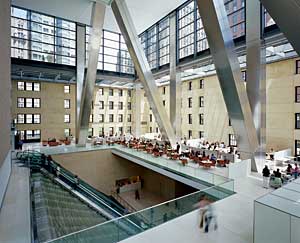Unless you have business up in the tower, you don’t even get to go up the escalator. A guard stands at its foot and shoos you away. So the one experience that ought to matter—that of rising on the escalator from the old building into the new tower—is denied to the public.

We dined on the uppermost of the 40 floors. Here, where the program changes from office use to eating space, you’d think there’d be an opportunity to articulate that difference in the architecture. But no. We’re still in the trusslike cage. In fact, when you look at the tower from outdoors, it appears to be arbitrarily lopped off at this point, as if the owner had run out of money during construction. The truss walls clearly want to be taller. They want a heavier wind load.
Still magical, of course, are the nighttime views from the dining room to Manhattan and its astonishing, seemingly infinite field of light. But that view was my only positive experience.
Trying to figure out my nasty reaction to the Hearst, I remember that, a few years ago, I visited a major exhibition of the work of the Foster office in the British Museum in London. This is the building where Foster created a skylit atrium court around the old circular reading room where Marx researched and wrote Das Kapital. (I’m not a fan of the atrium, either, with its deathlike pallor and emptiness, but that’s another subject.) The exhibition was impressive. Like him or not, Foster, with his partners and engineers, produces an amazing volume of work—work that is always inventive, carefully detailed, and fully thought through.
I was struck by a wall display of Norman Foster’s sketchbooks. The number seems improbable to me now, but my recollection is that the caption informed us that Foster had filled 800 such sketchbooks since he began as an architect. At any rate, there were an awful lot of them. Some were open. The sketches were not usually of places of any kind. Instead, most were technical. You could see Foster working out a joint detail, for example, or imagining the configuration of a section.
I have no real idea how Foster works. But combining my memory of the sketchbooks with my dislike of the Hearst, it occurs to me that perhaps what Foster does is create prototype buildings—buildings that, when he first imagines them, lack both a program and a site. His entry in the competition for the World Trade Center in New York certainly stuck me that way: a newly invented type of high-rise (two towers kissing near the top) that could be built anywhere, whether New York or Singapore, and could contain anything, a hotel or offices or condos or interplanetary rockets.
Whether it’s true or not, that’s the message the Hearst broadcasts to me: that it’s a prototype invented for no particular site or program which was, then, pulled out of its sketchbook and plopped down on this site. Its form not only communicates but insists that it ignores its solar orientation, its site, its Deco footrest, and its internal program of uses. “Put me anywhere, fill me with anything, I’m fine with that,” the tower seems to be telling us. It’s a throwback to Mies’s concept of universal space. And let’s remember that Mies’s concept, which worked well at Crown Hall in Chicago, created, in Berlin, an art museum that is as hopelessly impractical as it is handsome.
There are, of course, prominent architects and pundits today who believe we live in a single global culture. I’m of the opposite persuasion. I think one of the most important things architecture can do is, precisely, create difference, before the whole planet mixes and matches into the same gray soup everywhere. And the only way to do that is to be very sensitive and responsive to whatever is genuinely different in the site, the culture, the climate, the situation. As I’ve written in this column before, “Architecture is the art of making places.”



